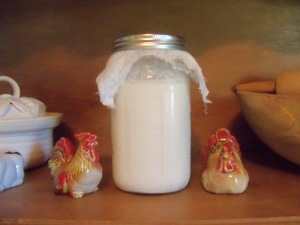Milk Kefir
Milk kefir has been around for a long time. Yet until a few weeks ago, was very new to me. I found the information from some of my favorite blogs here and here. So being adventurous and loving to try new foods, I purchased some from the local grocery store. What you purchase in store is much like a slightly fizzy drinkable yogurt. They have different flavors or plain, just like yogurts. But these are very expensive! So I set out to make my own...
There is a difference between yogurt and kefir. Kefir has more than 30 different strains of good bacteria. Yogurt only has 2 or 3 good bacteria. Milk kefir is thought to be more healthful. Kefir helps with digestion and restoring gut health. Kefir's bacteria sets up residents in the intestines. There they can continually aid in digestion and repel harmful bacteria. Yogurt must be eaten daily to get the full benefit. I still make yogurt and use it for smoothies, but I rely more on kefir for good gut health.
Some people have to start slowly with kefir. Others, like me, have no problem with digesting it. Most suggest to start with 1/2 cup per day and work your way up to more. The enzymes contained in kefir break down the lactose in milk. Making it easier for those with lactose intolerance to digest it.
- To make kefir you must first acquire some kefir grains. They are not actually grains but a living colony of good bacteria. They look much like cauliflower. I ordered mine here or another great and helpful website is here. You will receive a small amount of grains. They will grow and multiply, so be patience.
- Place your new grains in a quart glass jar of fresh milk. At first I was unsure if the milk needed to be heated. It does not. I found its actually better to use cold milk. Your kefir will ferment at a slower rate the cooler it is.
- Place some type of covering on your jar, cheese cloth, a coffee filter (my fav), dish cloth or other tight weaved cloth and secure with a rubber band. The kefir needs to get some air and let off any gases that are formed during fermentation. Also you need to keep any bugs out.
- Leave on the counter or a location that is fairly warm 70 to 80 degrees for 24 to 48 hours.The amount of time you leave it is up to you. A 24 hour kefir is smoother and is prefer by most people. After 48 hours the kefir will separate into curds and whey. You can stir the two back together but the consistency will not be as smooth. *Please separate different types of fermenting foods by a few feet so that contamination will not occur.
- After fermenting your kefir will be thick and creamy. Much like a drinkable yogurt or eggnog. Strain the kefir through a stainless steel small mesh strainer to catch your kefir grains.
- You may now add flavorings to your kefir. We like to add a small amount of honey.
- You can store your kefir grains in the fridge with a cup or so of milk until you are ready to make more kefir. Just note that the grains will be in a dormant state and may take longer to make the next batch of kefir. I thought I had killed my grains the first time I did this. I almost cried.... luckily the next day I had yummy kefir! Hooray! I rarely put my grains in the fridge. I keep one quart of kefir in the fridge and one fermenting on the counter. That way we always have fresh kefir.
Please find more info here on kefir and its benefits.


No comments:
Post a Comment